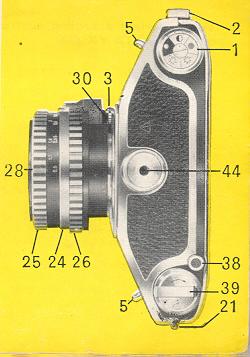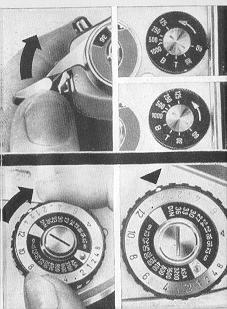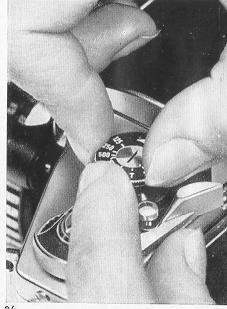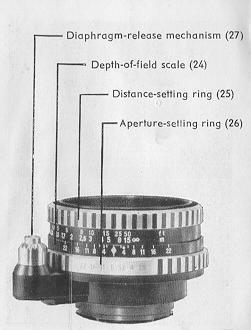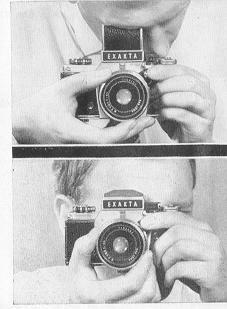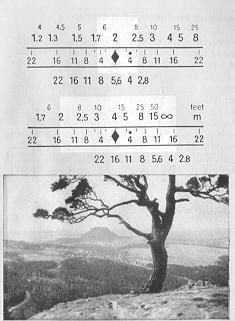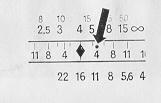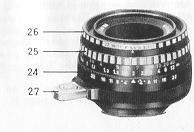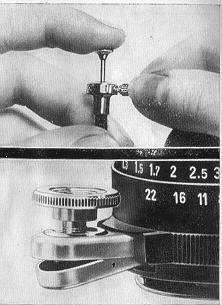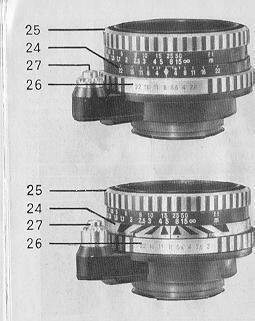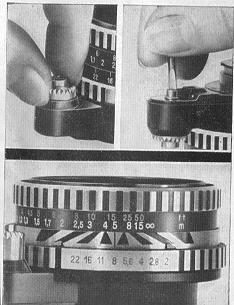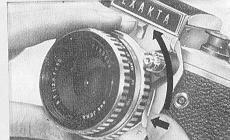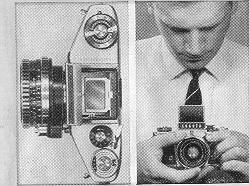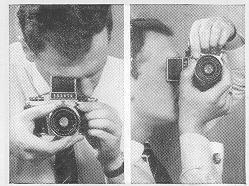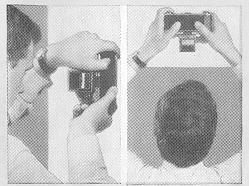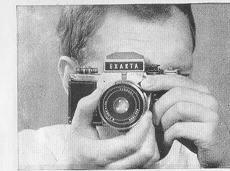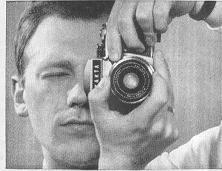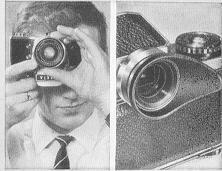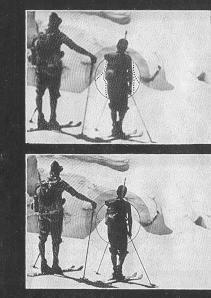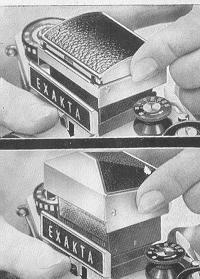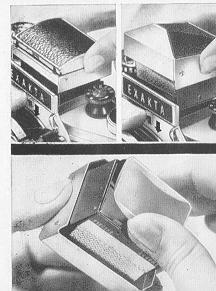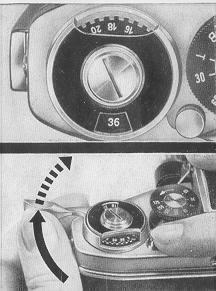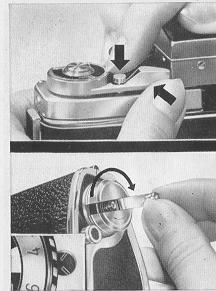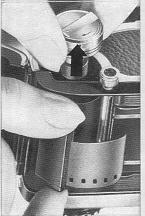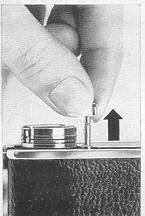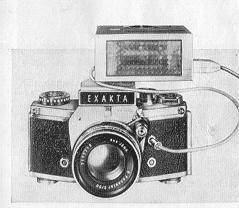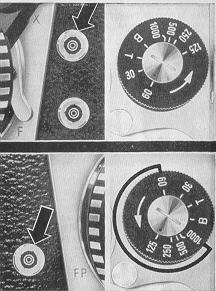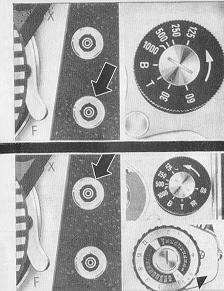EXAKTA VX 1000
posted 12-14-'02
This camera manual library is for reference
and historical purposes, all rights reserved.
This page is copyright© by ![]() ,
M. Butkus, N.J.
,
M. Butkus, N.J.
This page may not be sold or distributed without
the expressed permission of the producer.
On-line camera manual library
If you find this manual useful,
how about a donation of
$3 to:
M. Butkus, 29 Lake Ave.,
High Bridge, NJ 08829-1701
and send your e-mail
address
so I can thank you.
Most other places would charge
you $7.50 for
a electronic copy
or $18.00 for a hard to read Xerox copy.
This will help me to continue to host this site,
buy new manuals, and pay their shipping costs.
It'll make you feel better, won't it ?
If you use Pay Pal, use the link below.
Use the above address for a check, M.O. or cash.
Back to main on-line manuals pages
CLICK HERE TO CONTINUE TO
Exakta VX1000 PDF MANUAL
CLICK HERE FOR EXAKTA Bedienungsanleitung
PDF MANUAL IN GERMAN
- 2 pages at a time
EXAKTA
VX1000 Bedienungsanleitung - one page
Click here for a Word version of
this manual

We are delighted that you have chosen an EXAKTA and we wish you every success with your new camera.
We would like to advise you, however, to read this instruction manual carefully before you start using your camera. in this way you will obtain the greatest possible service from it, since you will eliminate from the outset the possibility of operating it incorrectly, and possibly damaging the mechanism. The EXAKTA is a high-quality precision instrument which can naturally only be expected to answer all your requirements when it is always handled correctly.

|
|
|
1. Knob for opening the camera
back with film-type reminder disc
2. Camera-back lock 3. Shutter-release knob 4. Pivoted shutter-release lock 5. Eyelets for carrying strop or Frame counter 6. Frame counter 7. Catch for interchanging the focusing systems 8. Rapid-wind lever for tensioning shutter and advancing film 9. Rewind declutching button 10. Small shutter-speed setting knob (for speeds from 1/30 sec. to 1/1000 sec., T and B) 11. Friction dog of rapid-wind lever 12. Flash contact "X" (primarily for electronic flash units) 13. Finder Hood |
 |
REAR VIEW

|
15. Swing-up focusing magnifier 16. Handle for swinging the focusing magnifier 17. Lever for opening the Finder Hood 18. Large shutter-speed setting knob (for speeds from 1/8 sec. to 12 seconds and also for delayed action at 1/4 sec. to 6 seconds) 19. Film-sensitivity reminder disc 20. Indicator disc for checking film advance 21. Camera-back hinge |
22. Flash contact "FP" (for flashbulbs) 23. Red aligning dot on camera (for changing lenses) 24. Depth-of-field scale or automatic depth of-field indicator 25. Distance-setting (focusing) ring 26. Aperture-setting ring 27. Release mechanism for lenses with fully automatic aperture (release knob or release rocker) 28. Lens |
|
29. Red aligning dot on lens 30. Lens locking lever 31. Flash contact "F" (for flashbulbs) 32. Take-up spool with blue pin 33. Chamber for take-up spool or cassette 34. Film-wind sprocket 35. Film-guide runners 36. Film gate with blind of focal-plane shutter 37. Film-cutting knife 38. Knob of film-cutting knife 39. Rewind crank 41. Chamber for cassette containing unexposed film |
|
|
42. Non-detachable hinged camera back 43. Exchangeable film-pressure plate 44. Tripod bush 45. Penta Prism 46. Eyepiece of Penta Prism |
|
|
Preparations for use The Finder Hood (13) is opened by pressing on the lever (17). To close the hood, press the front (14) backwards until it locks. The focusing magnifier (15) can be swung into either the working or rest position by means of handle (16). For further information on the use of the Finder Hood see page 34. Swing the shutter-release lock (h) out of the way, then release the shutter either by pressing directly on the shutter-release knob (3) or indirectly by depressing the release knob or rocker arm (27) on the lens. When you have finished taking pictures, swing the shutter-release lock (4) so that it covers the shutter-release knob (3), making shutter release impossible, thus avoiding unintentional exposures. |
|
Film loading Loading and changing the film must not take place in direct sunlight! The EXAKTA VX 1000 uses standard 35 mm miniature film, in cassettes of 20 or 36 exposures, to make negatives 24mm x 36 mm. Perfect film transport requires faultless film cassettes. Daylight loading spools should only be inserted in cassettes made by the same manufacturers. 1. Depress camera-back lock (2) downwards. Open hinged camera back. |
|
|
|
2. Pull out the rewind crank (39) by means of its knob. |
|
3. Insert the cassette containing the unexposed film in the feed chamber (41). Push the knob of the rewind crank back into the camera body. twisting the knob gently in either direction to engage the dog (40) with the bar in the cassette core. |
|
4. Remove the take-up spool (32) from the chamber (33). Push the beginning of the film under the clamping spring of the take-up spool and wrap one half turn round the core of the spool. |
|
|
5. Replace the take-up spool (32) in the film chamber (33) and turn it slightly in the wind-on direction so that the friction dog (11) of the rapid wind lever couples with the bar inside the spool core and allows the spool to be pushed right home into the chamber (33). |
|
|
6. Swing the rapid-wind lever (8) right up to its stop (if necessary first releasing the shutter). These two processes may have to be repeated until the teeth of the film-wind sprocket (34) engage with the perforation holes on both sides of the film. |
|
7. the correctly inserted film runs from the full cassette as tightly as possible over the film-guide runners (35) into the somewhat deeper lying film track and over the film-wind sprocket (34) on to the take-up spool (32). |
|
8. Closing the camera: This should be done by pressing the back lightly home until an audible click is heard. |
|
|
9. Expose two blank frames to wind on the fogged leader-length at the beginning of the film: release and swing the rapid-wind lever (8) as far as it will go. Once again: release and swing the rapid-wind lever (8) as far as it will go. |
|
|
10. Setting frame counter (6). Turn the disc of the frame counter (6) with the index finger to the left (anti-clockwise), until, when using a film with 36 exposures the figure "36", or when using a film with 20 exposures the figure "20" appears in the center of the window. The EXAKTA VX 1000 is now ready for action, and the frame counter will indicate after each exposure the number of unexposed frames still left on the film in the camera. To check the film transport observe indicator disc (20): the disc with its black-white mark orates, when the spool of the film-feeding cassette is revolving. |
|
11. When film is loaded, immediately set the film-type reminder disc in the back-opening knob (1) and the film-sensitivity reminder disc (19) as a reminder of the type of film that is in the camera. Both discs may be turned in either direction, until the appropriate reference is opposite the red dot, or, in the case of the film-sensitivity disc, opposite the black triangle. The film-type symbols have the following meaning: |
|
|
|
Using a take-up cassette
|
|
In place of the take-up spool (32), an empty standard-type film cassette may be placed in the take-up chamber (33). Take care to check the condition of this take-up cassette thoroughly: the core should move easily within the shell of the cassette and must not jam (if necessary the friction point of the cassette core may be lubricated by rubbing them with paraffin wax). When using a take-up cassette proceed as follows: attach the leader tongue of the film to the core of the cassette spool, ensuring that the bar in the core of the spool is on the right as the spool is turned away from the body, and insert the cassette so that the friction dog (11) of the rapid-wind lever (8) engages with the bar in the core of the spool. Then check that the film is pulled taut between the two cassettes, and is lying correctly between the guides, against the register rails in the deeper channel. |
|
|
It is not necessary to trim the beginning of the film specially. Any shape of leader can be used with the take-up spool of the EXAKTA VX 1000, either the narrow tongue provided on standard commercial cassettes, or, even better, a straight cut-across end as obtained when cutting lengths of film from bulk rolls. When employing a take-up cassette the film must be trimmed to suit the core of the cassette spool. For changing film, refer to page 41. |
|
|
Operating the shutter 1. The shutter is tensioned and the film wound on by operating the rapid-wind lever (8). This lever should always be swung right up to its stop, and will then spring back of its own accord. (The fast returning lever should be restrained gently with the thumb.) The tensioning of the shutter and the transportation of the film ore coupled (avoiding unintentional double exposures and blank frames). It is impossible to release the shutter before it has been fully tensioned and the film wound on. Never force the rapid-wind lever back from any intermediate point in its travel. Should the lever not spring back automatically when the camera is empty, the back (42) should be opened and the film-wind sprocket(34) turned a little towards the exposed-film chamber (33). The rapid-wind lever (8) should be gently nudged during this operation. |
|
2. The reflex image in the viewfinder (Finder Hood, Penta Prism or Lens Magnifier) will be visible even after the shutter has been released. (Instant return mirror.) The red warning signal in the reflex image indicates that the camera is not yet ready for action, and that the rapid-wind lever (8) must be wound before the shutter is ready for release (see illustration: reflex image seen through Penta Prism). |
|
|
3. Shutter speeds from 1/1000 sec. to 1/30 sec. can safely be employed without the use of a tripod. For exposure times of 1/8 sec. and longer, including delayed action exposures, the camera should be firmly supported (on a table, against a wall) or on a tripod. The tripod socket (44) is situated underneath the EXAKTA VX 1000. |
|
|
For all exposure times of 1/8 sec. or longer, or exposures using the delayed action, lenses having automatic diaphragms should be set to manual in order to avoid premature opening of the aperture. When using the Domiplan 2.8/50 lens, a cable release with a long plunger and time-exposure lock, or the special locking knob (available as an accessory) should be employed for the release rocker. For more information regarding this, see the detailed description of lenses on pages 28-31. |
|
Cable releases (with long plunger) may be screwed into the shutter release knob (3) on the camera or into the release mechanism on the lens (27). This is particularly important when using shutter speeds of 1/8 second and slower, and virtually indispensable when employing the B setting. See page 21. |
|
Selection of exposure times from 1/1000 sec. to/3o sec. (without
delayed action) |
|
|
The figures represent fractions of seconds: for example 30 = 1/30 sec, 125 = 1/125 sec. Intermediate speeds cannot be set. |
Shutter speeds from 1/8 sec. to 12 sec. (without delayed action)
|
|
Read also the instructions of page 18! Tension the shutter. Set the small shutter-speed setting knob (10) to T or B. Turn the large shutter-speed setting knob (18) in a clockwise direction until it stops; this tensions the speed-regulating mechanism. Then lift the outer ring of the shutter-speed setting knob (18) turn it until the yellow mark is opposite the desired black speed value and then let the outer ring spring back. The small figures 8, 4 and 2 signify fractions of seconds, e. g. 1/8 1/4 and 1/2 sec. The larger figures from I to 12 represent whole seconds (3 seconds Is represented by a dot). After a fairly brief exposure (e. g. '/s sec.) has been used, the speed-regulating mechanism will be only slightly run down; despite this, it should always be wound right up by turning the knob as far as it will go. |
|
Time exposures of any desired length (without delayed action) Read also the instructions on page 18! Select T or B on the small shutter speed knob (10) by lifting the knob and rotating it in the direction of the arrow until the required setting (B or T) is opposite the red dot on the center disc. Then allow the knob (10) to spring back. |
|
|
B: the shutter will remain open so long as pressure is maintained upon the shutter-release knob (3) or on the release mechanism of the lens. T: the shutter will open when the release knob (3) or the release mechanism on the lens is operated and will close again upon a second pressure. The B and T settings are very important for taking night and indoor exposures. |
|
|
Setting of shutter speeds from 1/1000 sec. to 1/30 sec. (using the
delayed action) |
|
Rotate the large shutter-speed knob (18) clockwise as far as it will go, and set it to any of the red figures as described on page 20. |
|
|
Red figures represent delayed-action exposures with which the shutter opens approximately 12 seconds after pressing the release. |
|
Selection of shutter speeds from 1/4 to 6 seconds, using the delayed
action |
|
|
The smaller figures 4 and 2 represent fractions of seconds, i.e. 1/4 sec. and 1/2 sec., large figures from 1 to 6 represent whole seconds. (The dot 3 seconds.) |
|
|
Red figures represent delayed-action exposures with which the shutter opens approximately 12 seconds after pressing the release. |
|
|
Intentional double exposures With the EXAKTA VX 1000, it is not possible for unintentional double exposures to occur. It is, however, possible to take double exposures on purpose (e. g. for trick photography). After the first exposure, the shutter can be re-tensioned without winding on the film as follows: turn the small shutter-speed setting knob (10) as far as it will travel in the direction of the arrow, without lifting it; the knob should be held to prevent it from springing back. |
|
Operating the lens 1. The aperture value (f/No) is selected by means of the aperture-setting ring (26). Turn this ring until the desired f/No on the aperture scale is opposite the mark. For instructions on operating the diaphragm mechanism, see the sections dealing with the various lenses on page 28 onwards. The smaller aperture numbers e. g. f 2, 2.8, 4, indicate relatively large diaphragm openings: permit brief exposures, but give only shallow depth of field. The larger aperture numbers. e.g. 16, 22, indicate relatively small diaphragm openings requiring longer exposure but giving great depth of field. Further information on the depth of field will be found on page 27 |
|
|
|
|
|
2. The lens is focused by turning the distance-setting ring (25) and observing the definition of the reflex image in the viewfinder. The lower values on the distance scale indicate meters, whilst the larger values above them represent feet. All distances are measured from the back of the camera to the subject. When the image of the subject in the reflex viewfinder attains us sharpest definition, then the correct camera-subject distance in feet or meters will be in line with the red setting mark. For further information on using the Fresnel lens (with micro-prism field) see page 38. When focusing the reflex image use the maximum aperture of the lens (i. e. smallest f/No) to obtain the most brilliant image, and then stop down just before the exposure. It is not necessary to take the camera from your eye, since all the lenses are equipped with fully-automatic spring or pressure diaphragms. For more detailed information see the descriptions of the lenses on page 28 onwards. |
|
Reading off the depth of field When the depth of field is great, objects at widely varying distances from the camera will form a sharp image. The precise extent of this sharp zone will be indicated (after focusing) by the depth-of-field scale (24) on the lens: on either side of the red distance-setting mark you can read off from the distance scale where the depth of-field zone begins and ends for any specific aperture setting. If the relevant f/No. on one side of the central distance-setting mark is in line with the infinity symbol (--) or even beyond it, then the depth of field will extend right up to infinity. On the right are two examples and a photograph demonstrating large depth of field. Above: Distance setting 2 meters (61/2 ft), aperture f 5.6 = depth of field extends from 1.7 m (51/2 ft) to 2.5 m (8/2 ft) Below: Distance setting 4 meters (13 ft), aperture f 16 = depth of field extends from 2 meters (6/2 ft) to infinity (00) The Pancolar 2/50 mm lens from Jena has an automatic depth-of-field indicator; see page 31. |
|
|
Focusing for infra-red pictures When using infra-red film, first focus the reflex image normally, then note the distance indicated by the red setting mark (either in feet or meters, or the infinity symbol), and turn the focusing ring to set this distance against the red dot (infra-red setting mark) which is either to the right or the left of the normal setting mark. By doing this the image produced by the invisible infra-red rays, which lies at greater distance from the lens than the image formed by visible light, will be brought into sharp focus in the film plane of the camera and consequently will appear sharp in the negative. |
Fully-automatic pressure diaphragm on Domiplan 2.8/50 lens: Always open the diaphragm fully for focusing. Pre-select the required smaller aperture (larger f/No) by turning the aperture setting ring (26); intermediate settings between the marked f/ numbers can also be selected. By depressing the release rocker (27), the lens will stop down automatically; when the pressure on the rocker is relaxed, the diaphragm re-opens automatically. The release rocker should therefore be held down until the shutter has closed. To check the depth of field when focusing, the release rocker (27) may be depressed part way so that the diaphragm closes down without releasing the shutter. |
|
|
|
|
In order to avoid premature opening to the aperture, for longer exposures, both when using the large shutter-speed setting knob (18) and when employing the B and T settings on the small speed-setting knob (10), and also for all delayed-action exposures, either of the following procedures should be adopted: Screw a cable release with a long plunger and time-exposure lock into the release rocker. In this way pressure can be maintained on the release rocker or body-shutter release for any desired period without having to keep ones finger constantly on the release (also eliminating camera shake). Alternatively, a special locking knob (available as an accessory) can be screwed into the release rocker; by propping up the lower part of the rocker the automatic diaphragm mechanism will be disengaged. The lens is then stopped-down (i. e. a numerically-larger aperture value is selected) by turning the aperture-setting ring. The lens opening will remain stopped down according to the extent to which the ring is rotated. |
|
Fully automatic spring diaphragm on T 2.8/50 from Jena and Pancolar 2/50 lenses from Jena
|
|
Engage the automatic diaphragm mechanism by pushing the release knob (27) on the lens towards the camera together with it5 mount and turn it to the right (viewed from the front of the camera). To disengage the automatic diaphragm, press the release knob (27) together with its mount towards the camera and turn it to the left (again looking from the front). When the automatic mechanism is disengaged (= manual diaphragm setting), the diaphragm will remain stopped down to the selected f/No (this is Important when using slow shutter speeds and delayed-action exposures). When the automatic mechanism is engaged, the diaphragm should be fully opened for focusing. Select the required smaller aperture (larger f/number) by turning the aperture-setting ring (26), which can also be set to intermediate stops. By depressing the lens-release knob (27) the diaphragm is stopped down automatically; by letting go of the release knob (27) the diaphragm re-opens automatically. |
|
Pressure on the release knob (27) should not be relaxed until the shutter has closed. To check the depth of field whilst focusing, depress the lens-release knob (27) just far enough to stop down the lens as required without releasing the shutter, In order to ensure that the shutter-release knob (3) on the camera body is always depressed far enough to trigger the shutter, the setscrew on the release mechanism of the lens should be adjusted to the required length with a screwdriver. A cable release with a long plunger can be screwed into the lens-release knob (27). Automatic depth-of-field indicator on the Pancolar 2/50 lens: After setting the aperture and distance, follow the appropriate black/white bands from the two movable black markers to the distance scale, upon which the depth-of-field range can be read off. Example: aperture setting f 8, distance 5 meters (17ft) = depth of field from barely 3 meters (10 ft) to over 15 meters (actually 23 meters or 76 feet). |
|
|
3. Changing the lens (28) (select automatic on all lenses from Jena): depress the locking lever (30) towards the lens, then turn the lens to the left until the two red dots (23 and 29) are in line, and lift the lens out towards the front. To insert a lens proceed in the reverse sequence: line up the red dots, and turn the lens to the right until it locks. All special-purpose lenses can be used, with focal lengths ranging from the shortest to the longest. |
|
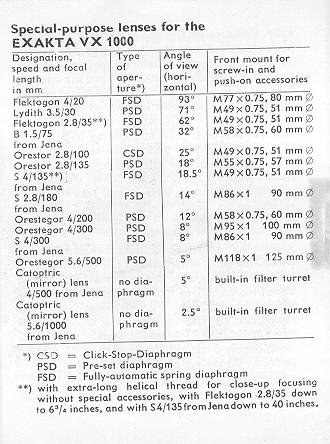
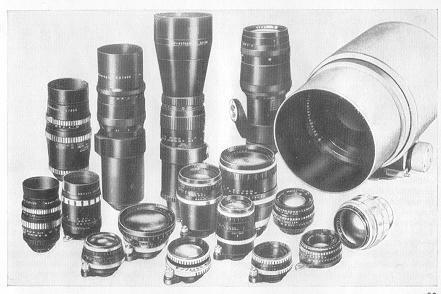
| Using the Finder Hood
The reflex image in the Finder Hood (11) of the EXAKTA VX 1000 may be used both for selecting or framing the subject, and also for focusing and checking the depth of field, by provisionally stopping down the lens. Generally, a large enough image for normal view finding purposes will be obtained when using the standard ground-glass screen or the Fresnel screen; for critical focusing, however, we recommend the additional use of the Focusing Magnifier. The pivoted Focusing Magnifier (15) will spring into its working position when the Finder Hood is opened, but can be folded back out of the way by operating the handle (16); see also page 6. Refer to page 38 for instructions on the use of the Fresnel screen. Normally, the EXAKTA VX1000 is held at chest or shoulder level. When the pivoted supplementary Focusing Magnifier (15) is also used. |
|
| the camera must be held close to the eye. When taking vertical pictures with the Finder Hood it is possible to shoot at right angles. This is particularly useful for working inconspicuously since the photographer can remain in concealment. |
|
|
|
|
(The Penta Prism makes it possible to take vertical pictures with a direct line of vision and also provides a laterally-correct and upright viewfinder image.) The image on the ground-glass screen of the Finder Hood (13) can also be observed from below when the camera is held above the head. This will prove very useful when taking pictures over walls or over the heads of crowds. Users who normally wear spectacles should use their close-up (reading) glasses for focusing with the Finder Hood. For interchanging the Finder Hood. see page 39. |
|
|
Using the Penta Prism The Penta Prism serves the same purpose as the Finder Hood, with the exception, that the reflex image on the ground-glass screen will invariably be upright and laterally-correct no matter whether the camera is held horizontally or vertically; this is particularly useful when taking pictures of moving subjects, since the image in the viewfinder will move in the same direction as the subject itself. With very rapidly-moving subjects the camera can thus be "panned" by swinging it gently in the direction of motion of the subject (as for example, with racing cars). When employing the Penta Prism (45) the camera should always be held at eye level. Viewing the reflex image through the eyepiece (46) may be effected with either eye. |
|
|
|
|
|
|
|
|
should use their distance glasses for focusing with the Penta Prism. Refer to page 38 for instructions on the use of the Fresnel screen. -- For fitting and removing the Penta Prism see page 39. An invaluable accessory for use with the Penta Prism is the flexible eyepiece cup: this is fitted on to the eyepiece (46) of the Penta Prism and shields it from distracting stray light. It is also helpful for spectacle-wearers since vision-correction lenses made by ones optician can be inserted into the revolving mount, making it possible to focus without wearing glasses. |
|
|
|
Focusing with the Fresnel screen The EXAKTA VX 1000 may optionally be supplied with a Fresnel screen. With this screen, focusing is mainly performed using the centrally placed matt ring without the fresnel line structure. To increase the accuracy of focusing, a microprism is centered in this ring. The extra brilliant image visible in this patterned field serves for focusing in the same way as the image on the ground-glass screen, except that with the microprism, incorrect focusing will result in an image which is blurred to a greater degree. The lens will be correctly focused when the image in the microprism is at its sharpest. It is, however, absolutely essential to focus with a large aperture, as with apertures off 5.6 and smaller, the image in the microprism field will appear relatively sharp, even with the lens incorrectly focused. This, of course, will lead to unsatisfactory results. For extreme close-ups of magnifications greater than 1:1, and photomicrography, the microprism cannot be used. |
|
Interchanging of the focusingsystems The focusing systems of the EXAKTA VX 1000 (Finder Hood, Penta Prism, Lens Magnifier, see last page) are interchangeable. The Finder Hood (13) must be closed when the Finder Hood insert is being removed from the camera. When any of the viewfinder inserts are being removed from the camera, the viewfinder-retaining catch (7) must be pressed downwards, and the Finder Hood, Penta Prism or Lens Magnifier withdrawn upwards without tilting. On replacing a viewfinder unit, it must be inserted squarely and vertically, and be pressed downwards until it clicks into position. Never use force. |
|
|
|
Exchanging the focusing screen or Fresnel screen The focusing screen or the Fresnel screen of the viewfinder systems of the EXAKTA VX 1000 are interchangeable, so that, if desired, the ground-glass screen, the Fresnel screen, the ground-glass screen with field framing, one of the special focusing screens or the flat ground-glass screen (see last page) may be used. When fitting or removing a focusing screen or Fresnel screen from the Finder Hood insert, the Finder Hood (13) must be closed Remove the viewfinder insert as described on page 39. The focusing screen or Fresnel screen should be gripped by the long sides, and withdrawn from the viewfinder. -- To refit the focusing screen, Fresnel screen or flat ground-glass screen it should again be held by the long sides and pushed in between the securing springs of the viewfinder system. Never touch the matt surface of any screen. (With the Finder Hood insert, the Finder Hood must first be closed.) |
|
Changing the film If the frame counter (6) has been correctly set when loading the film, then
after the 20th or 36th exposure, the number 36 will appear in the frame-counter
window. It may be possible to expose one or two further frames before the film
can no longer be transported. |
|
|
|
1. Depress the rewind button (9) and secure the rapid-wind lever (8) with a light pressure in the slot of the rewind button, so that it stays in the rewinding position. (The next time that the rapid-wind lever (8) is wound, the rewind button (9) will spring back into its normal position, and the camera would then again be ready for forward transportation of the film.) 2. Hold the camera in the left hand. Swing out the rewind crank, and with the right hand turn it evenly and slowly in a clockwise direction, until it is felt that it turns more easily. The film has now been rewound. (If the film is rewound at too great a speed, static electricity will cause discharge marks to appear on the negatives.) If the film is being correctly rewound, the indicator disc (20) will show this by revolving also. |
|
|
|
|
3. Open the camera back. Withdraw the rewind crank (39) by means of its knob, and remove the cassette of exposed film from the camera. Depress the knob on the rewind crank to push it back into the camera. When an empty film cassette is used in place of a take-up spool, rewinding is not necessary. As soon as the end of the film is reached (when the rapid-wind lever (8) can no longer be operated, see page 41), cut off the film on the feed side of the film gate (36) by means of the built-in film-cutting knife (37): |
Withdraw the knob (38) about 1 3/4 inches from the camera body. Then press the knob (38), returning it to its rest position. Wind on, and expose two blank frames, in ord. to draw the end of the film across into the take-up cassette. The film-cutting knife (37) should also be employed in the manner described above whenever it is desired to remove a take-up spool containing a partially exposed film from the camera. |
|
|
Flash Photography The EXAKTA VXI000 has three connections for flash synchronizing: Outlet X (12) for open flash technique with electronic flash units and flashbulbs. Outlet FP (22) and F (31) are for the use of flashbulbs. The synchronizing cord of standard and electronic flashguns should be connected to the appropriate socket as indicated in the table. The shutter must always be tensioned before connecting a flashgun. Should a flashbulb fail to fire, e. g. through poor contact in the circuit, the shutter must be in the released position before the bulb is removed. Do not insert a new bulb until the shutter has been re-tensioned. |
|
Use of electronic flash units (open flash technique) The synchronizing cord should be connected to the X contact (12) and the shutter set to 1/60 second or slower. When using electronic flash-guns without storage condensers, designed for mains operation only, the shutter must be set to 1/8 second. The effective exposure time, however, is the duration of the flash, and not the t i me that the shutter remains open. |
|
|
Use of long- burning flashbulbs (full synchronization) Conned the cable from the flashgun to the FP contact (22) and select the shutter speed according to the table. With full synchronization, this will be the effective exposure time. |
Flashbulb Chart
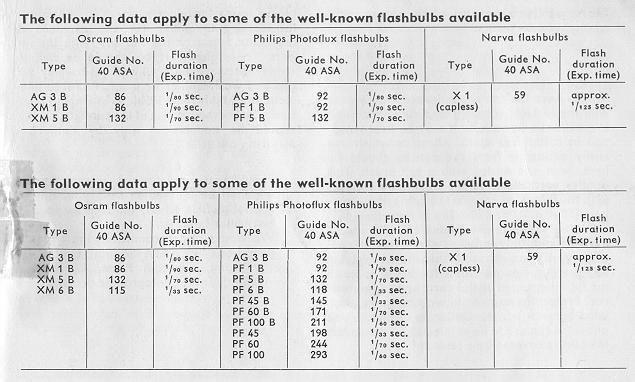
|
Use of fast-burning flashbulbs(open flash technique) Connect the cable of the flashgun to the F contact (31) and set the shutter to 1/30 second. The effective exposure time will be determined by the duration of the flash, and not by the shutter speed. |
|
|
Use of all types of flashbulbs (open flash technique) Connect the cable of the flashgun to the X contact, and set the shutter to 1/8 second or longer. The effective exposure time will be determined by the duration of the flash, and not by the shutter speed. |
Care of the camera and lenses
Always keep the camera in its ever-ready case with the lens (or lens cap) and viewfinder unit in position; alternatively it may be kept wrapped in a fluff-free cloth. All parts which are easily accessible from the outside should be kept clean and dusted with a soft brush. This applies particularly to the film-guide runners (35), the film-wind sprocket (34), the film chambers (33 and 41) and also the camera back (42) including the pressure plate (43).
The reflex mirror should only be dusted when absolutely necessary, using a clean soft brush without applying any pressure; do not allow the brush to touch the lightly-greased metal surround of the mirror. Protect the camera against moisture, dust, wind-borne sand, etc. Under no circumstances allow the camera to be pointed at the sun unless the lens Is covered by a lens cap! Never touch the glass surfaces of the lenses. the focusing magnifier (or the eyepiece of the Penta Prism or the mirror) with the fingers. These glass surfaces should be cleaned when necessary only with an extremely soft piece of wash-leather or a soft, fluff-free linen cloth. It is highly inadvisable to attempt to interfere with the mechanism of the camera; repairs should be undertaken only by authorized servicing agencies. Should you want further information, we shall be pleased to send you any special leaflets. Kindly let us know your particular interests. We would also recommend the following book "EXAKTA Manual" by Werner Wurst (Fountain Press, London). Available from photographic dealers.
Accessories
|
Accessories increase the versatility of the EXAKTA VX 1000 and are for some applications indispensable. The following are available: Finder Hood Penta Prism Fresnel Screen with Microprism grid Ground-glass Screen with Field Framing Eyepiece cup for Penta Prism Ever-Ready Case Lens Hood with screw-in mount Giant release button, to enlarge the release button Accessory shoe Special locking knob (for Domiplan 2.8/50 lens) Bayonet rings and tubes, as well as Two-in-one ring, for close-ups |
Miniature Bellows Attachment Autocouple
Extension Release, for close-ups "Vielzweck" (Multi-Purpose) equipment for
close-ups, reproductions and macrophotography, etc., consisting of the following
parts:
Swing Angle Attachment Large Bellows Attachment Transparency Copying Attachment Copying Stand and Repro Unit (with Lighting equipment, if required) T 2.8/50 Special lens from Jena, in sunk mount Lens Reversal Ring Adapter Ring for using photomicrographic lenses Lens Magnifier insert with Top Lens Flat Ground-glass Screen Special Focusing Screens Macro-Micro Photometer Ringflash Units RB 1 and RB 2 Kolpofot Endoscope Attachment and Overrunning Switch Unit Spectroscope Adapter Ring with sleeve Adapter for Astrophotography Microscope Attachment The illustrations in this manual may differ in certain details from the actual appearance of the camera and its accessories. |
